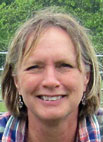
Through a thick, deep pasture in a valley on the Chevallier farm grazes a gentle, peaceful herd of Katahdin sheep. Dr. Beverly Chevallier, who practices at her veterinary clinic in Western Grove, Ark., is focused on growing quality sheep for the meat market. She implements grazing and managing techniques, and couples a beef herd as well, to meet her production goals.
Dr. Chevallier has been actively working on improving her pasture and hay grounds. Her predominately fescue pastures suffered through last year’s drought and heat. “Last summer, this was all brown and grazed to the ground, so I broadcast seed in all the pastures, and also in my bermudagrass hayfields,” said Dr. Chevallier, pointing out the lush pasture. “I had a mixture of Crimson Clover, Vetch, Red Clover, Arrowleaf Clover and Ryegrass broadcast with a little fertilizer used as a carrier.”
Her pasture management includes rotationally grazing the sheep through four separate pastures. “I use netwire to go around the perimeter of all the pastures that I keep sheep in. Sheep won’t try to get out of a pasture though, not like goats will.” Dr. Chevallier rotates her beef herd behind the sheep through all four of the pastures. “There are also four other pastures that the cattle rotate through, and the sheep do not.” She explained that these pastures are in areas further from the barns, and predators are more present. The rotational grazing benefits the pasture by giving grasses a chance to regrow between cycles and distributing manure more evenly to be better utilized for fertilizer. Dr. Chevallier has also seen a reduction of parasites in her stock due to the multi-species approach to rotational grazing. “I haven’t treated for parasites in at least a couple of years.”
Dr. Chevallier likes the Katahdin breed, “It’s a hair sheep that does very well in our area. They are grown for meat and do not need to be sheared.” She keeps 50 ewes, breeding them only once a year, “Sheep are short season breeders, seasonally polygesterous, I will put the buck in with the flock in October, so they will lamb in March,” She also added, “I like to flush the ewes with corn daily, 21 days before breeding. This stimulates them to ovulate more to produce more multiple births.” When lambing time comes in March, Dr. Chevallier watches over them closely, keeping them in individual pens in her barn. This helps the ewes identify their own lambs, and makes it easier to see if there are any problems with the lambs or ewes.
When the male lambs are 100 pounds in weight, they are sold at a market specializing in grass fed meat. The ewes are sold to other sheep farms, “I have had up to 200 ewes at a time, and that was too many. I keep the number of ewes more manageable now and focus on quality instead of volume.” Dr. Chevallier only breeds her sheep to lamb once yearly to keep stress low for her ewes, “I have happy sheep, which is important.” She said that eight sheep can be kept on the amount of pasture it takes to keep one cow.
Besides the sheep and cattle, she keeps busy with her vet clinic, breeding exotic breed cats with her sister, and teaching karate during the evening.







